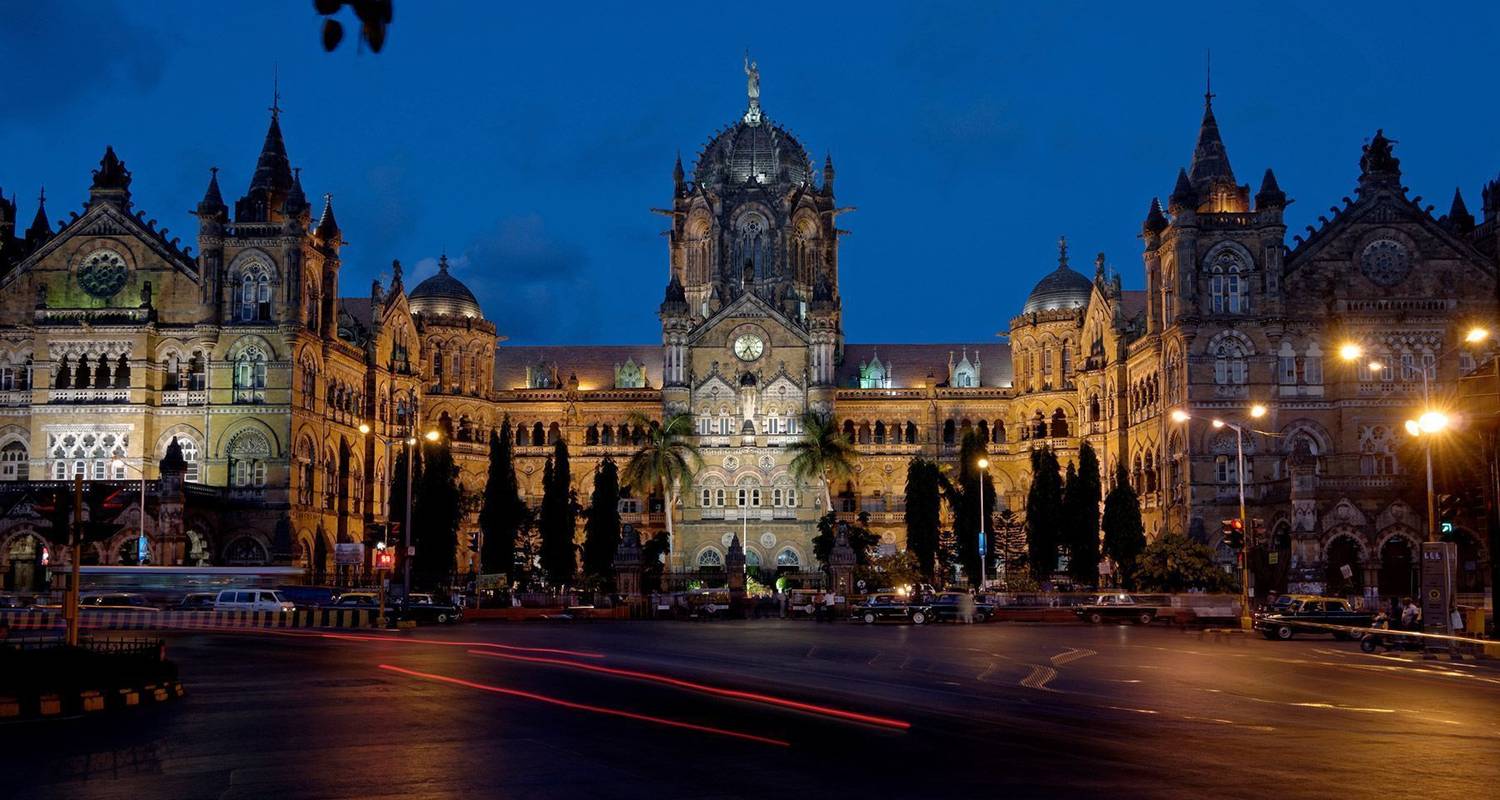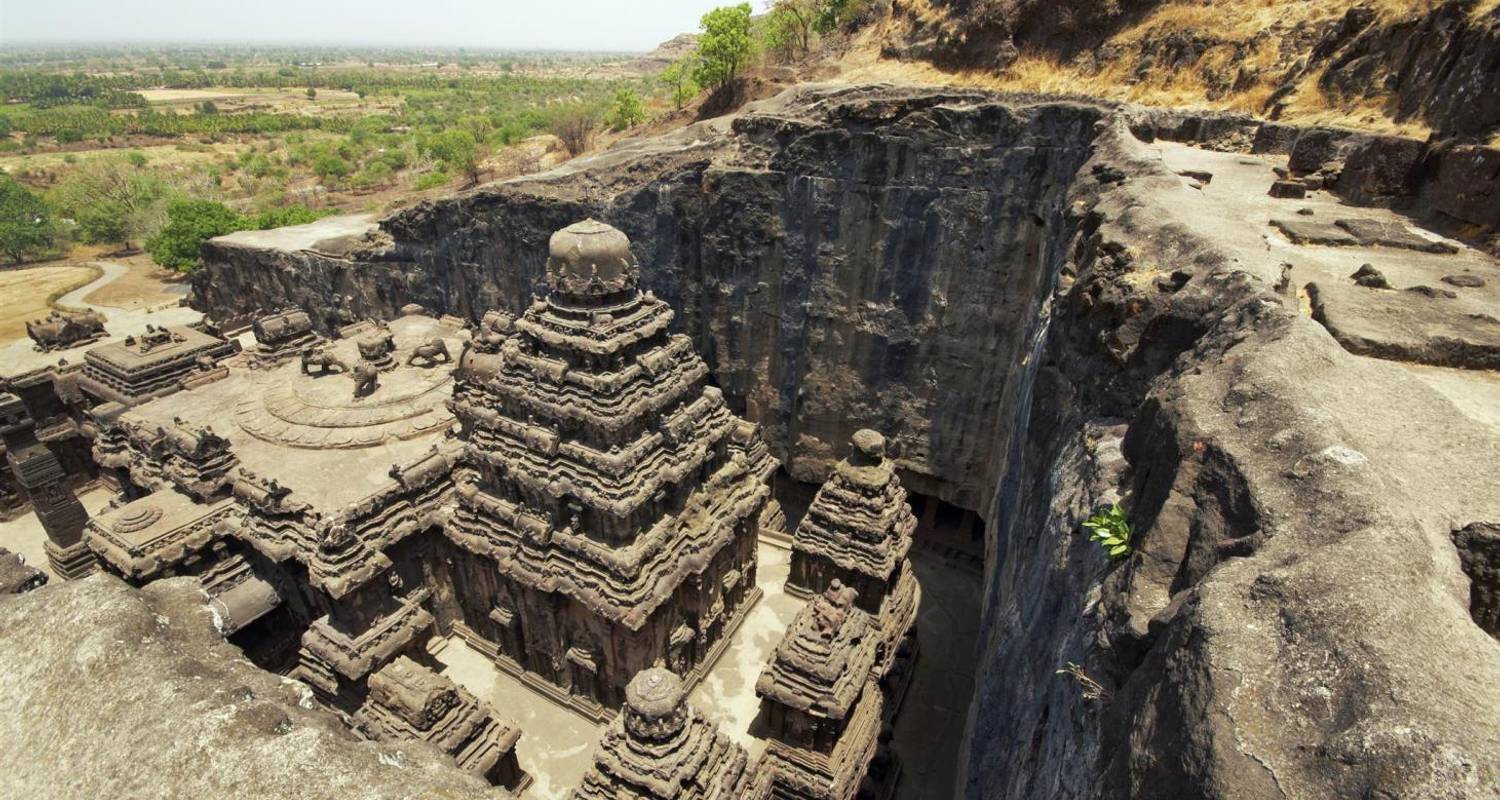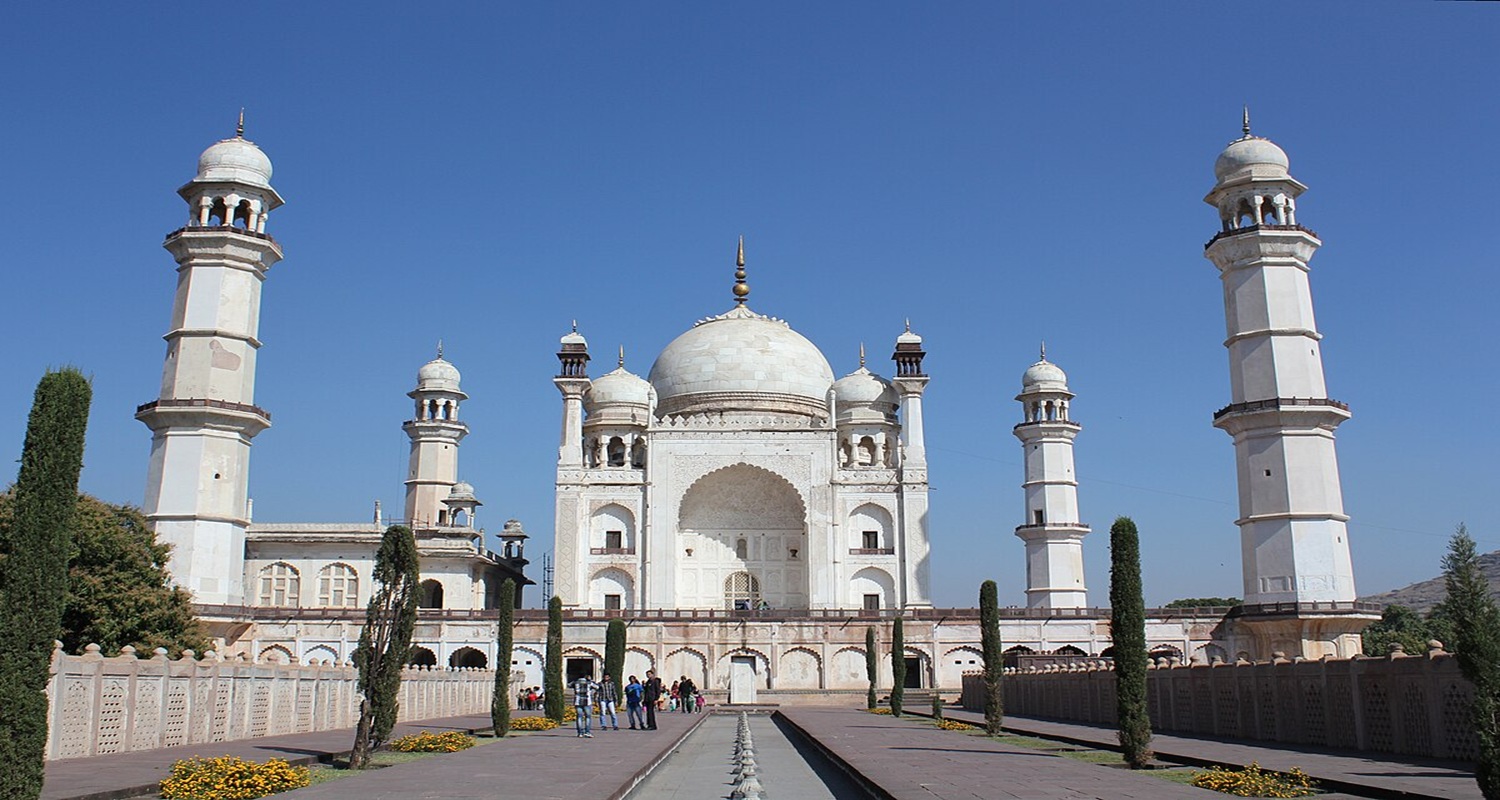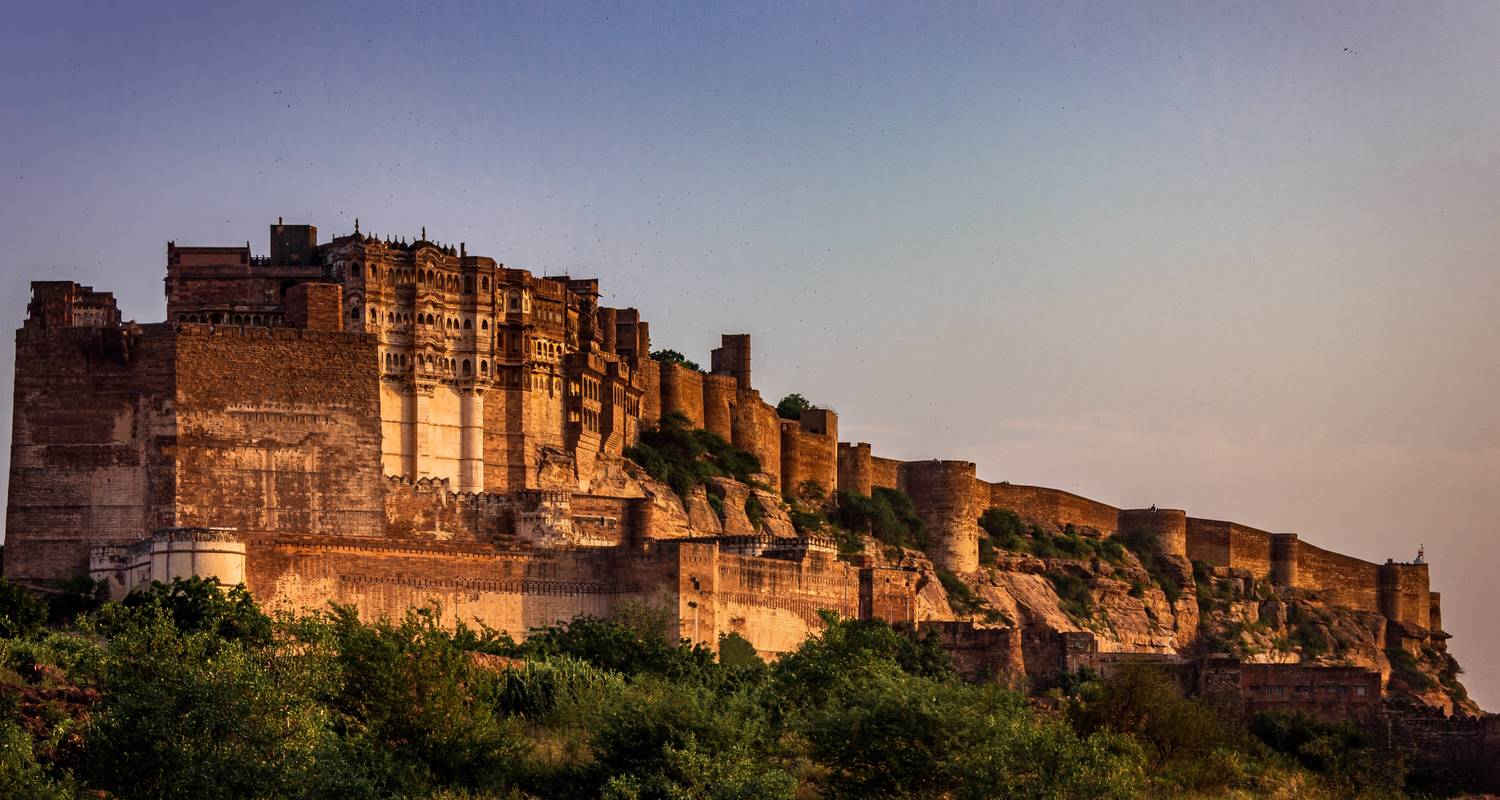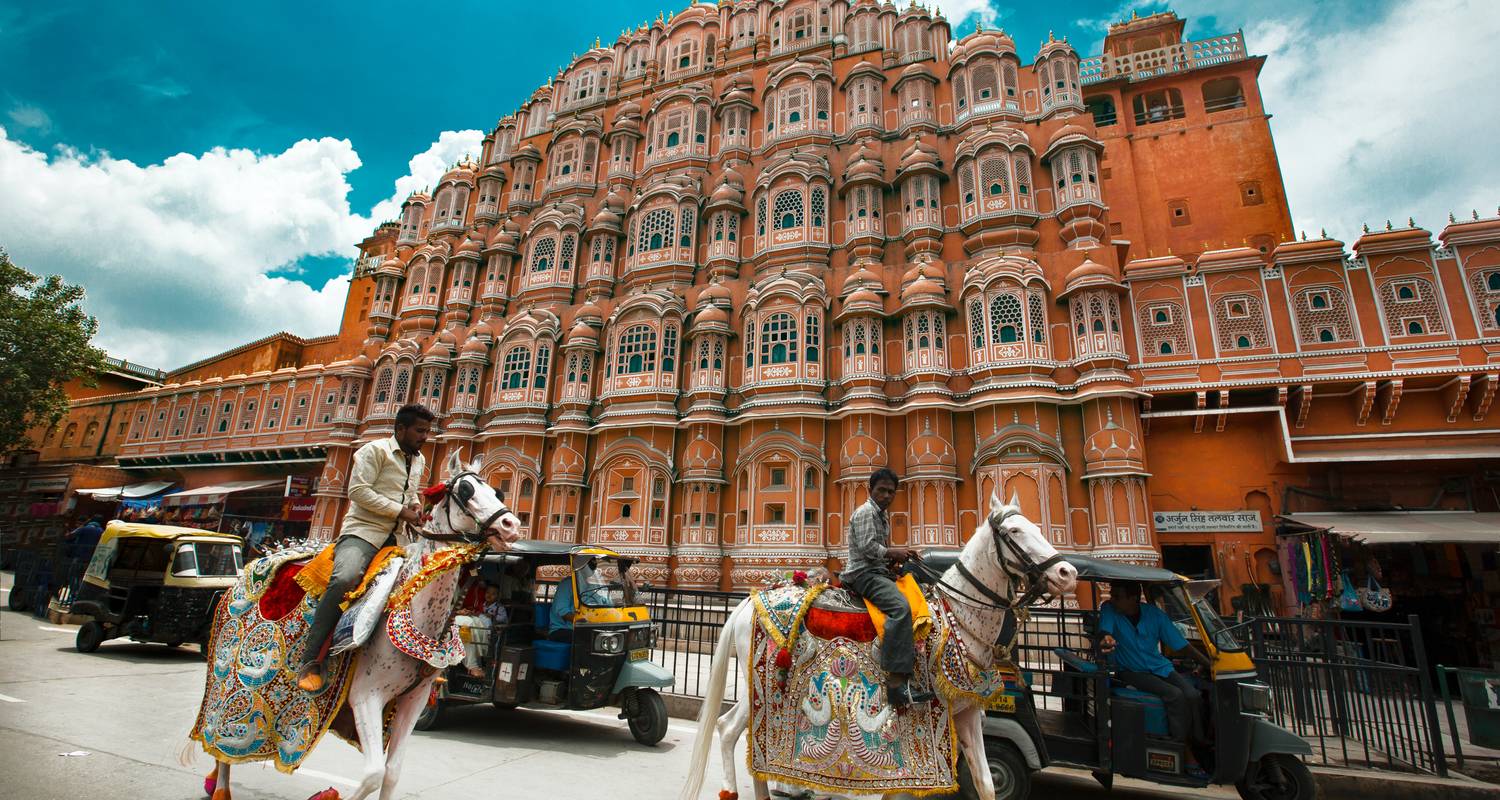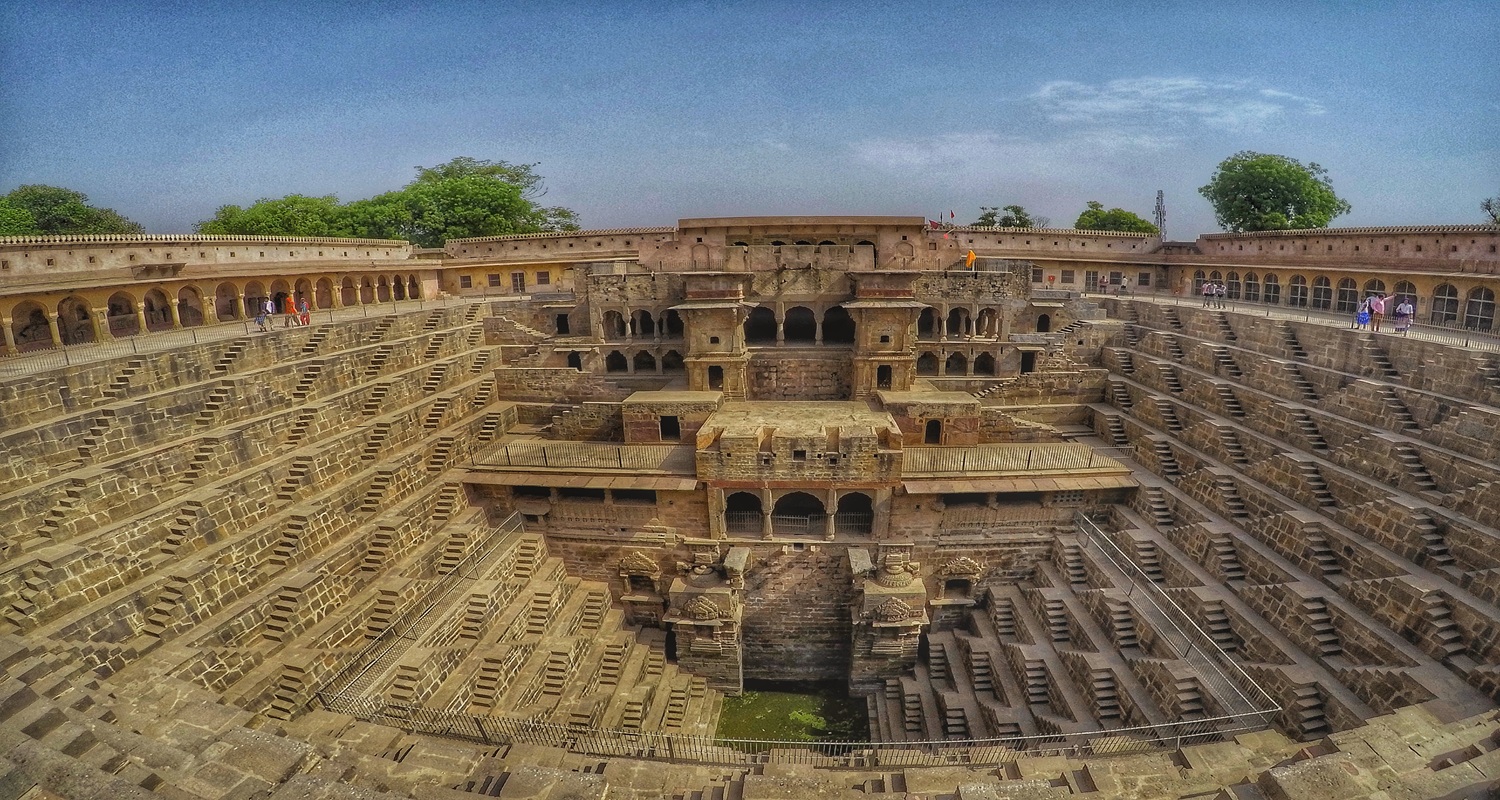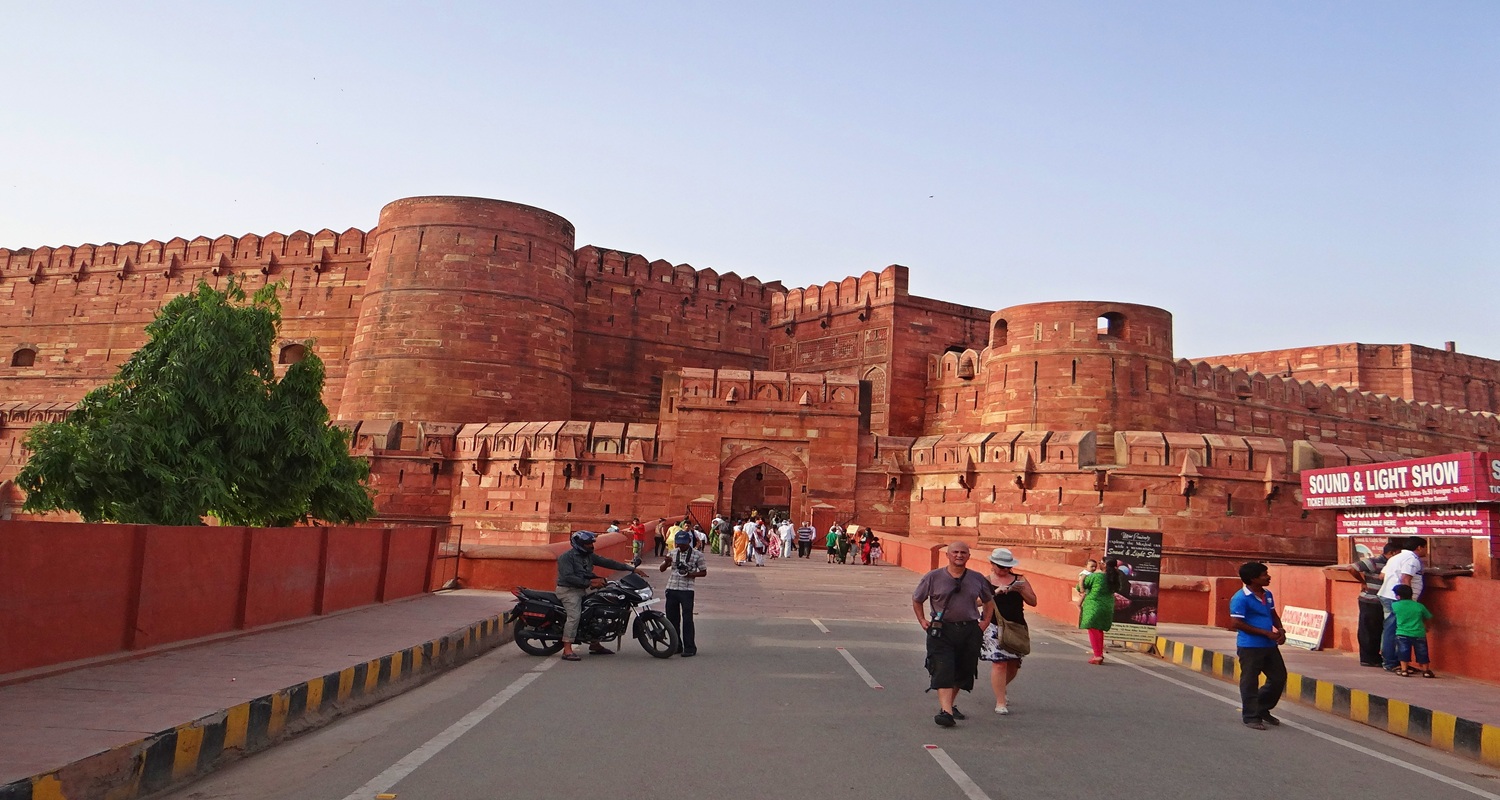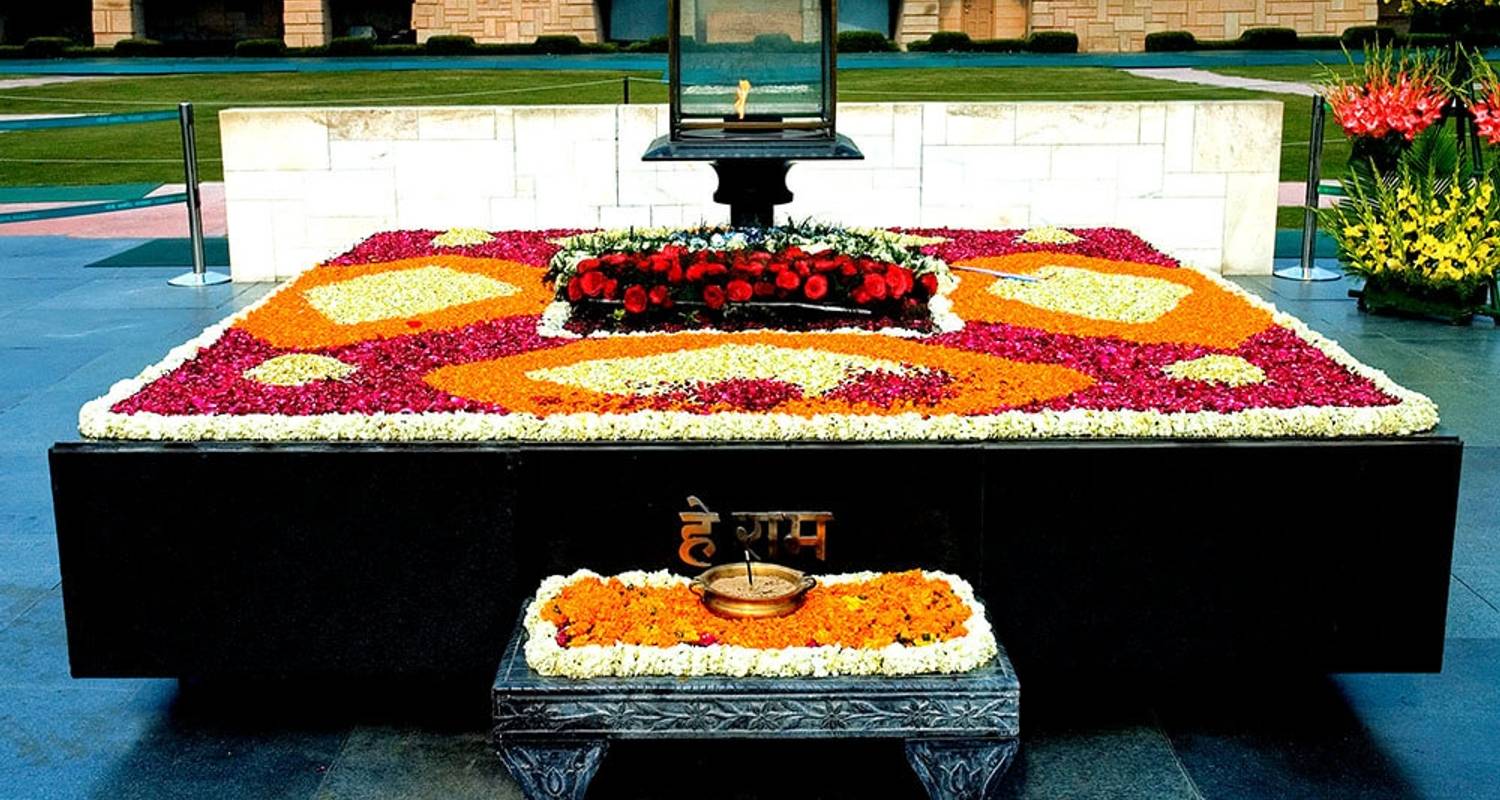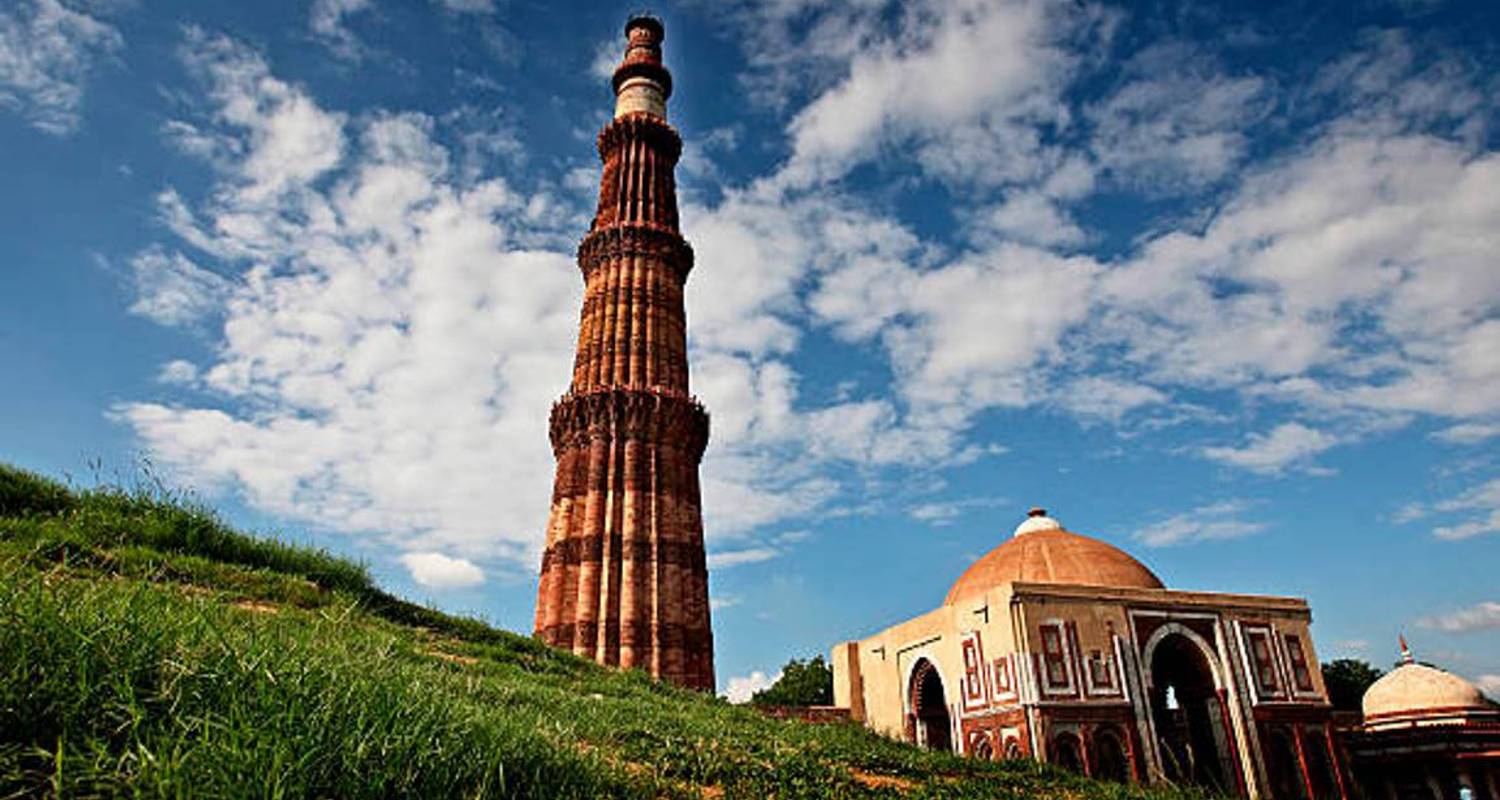
Rajasthan
Rajasthan With Ajanta Caves & Mumbai
NotIncluded
INR 110600 Per Person
3-4-5 stars
Travel Duration
11 Days / 10 Nights
Included in the trip
Individual departures
Round The Year
This tour is a combination of most interesting places of Rajasthan, along with Agra, Aurangabad and Mumabi. The Tour start in capital city of New Delhi, and then enters in to Rajasthan visiting Agra, Jaipur, Jodhpur, Udaipur and Finsishes at Mumbai with an excursion to Aurangabad. Rajasthan, the "Land of Kings," is a state in northern India that offers a magnificent mix of rich history, vibrant culture, and natural beauty. A tour of Rajasthan can be an unforgettable experience, where you can explore majestic forts, ancient palaces, colorful bazaars, and desert landscapes. A tour of Rajasthan is a journey back in time, where you can immerse yourself in the state's rich history, vibrant culture, and stunning landscapes. From majestic forts and palaces to bustling Bazaars and serene lakes, Rajasthan offers something for everyone and is truly a traveler's delight. Aurangabad, located about 400 km east of Mumbai, is a city steeped in history and culture. It was founded by the Mughal emperor Aurangzeb in the 17th century and was named after him. The city is famous for its UNESCO World Heritage Sites like the Ajanta and Ellora caves, which are ancient rock-cut temples and monasteries that showcase the exquisite artwork and architecture of the time. The city is also known for its medieval monuments like Bibi Ka Maqbara, which is often compared to the Taj Mahal due to its similar design and architecture. The Tour would end in The Financial Capital of Mumbai. The city has a rich history, with influences from the British, Portuguese, and Marathas, and is known for its iconic landmarks like the Gateway of India, Chhatrapati Shivaji Terminus, and Marine Drive. This tour is an incredible way of Exploring best of Rajasthan and Maharashtra.
Stages Of Tour
Day 1
ARRIVAL IN DELHI & SIGHTSEEING
Welcome to DELHI, The Capital of India. Your flight would land at INDIRA GANDHI INTERNATIONAL AIRPORT. After landing kindly head towards the immigration department and get your passport stamped. Immigration Department would stamp the Visa on your Passport. After the Immigration and Custom check Kindly Take an Exit from the Airport from Exit Gate No 4.
MY TOUR ADVISOR’S Representative would be waiting for you to welcome you outside the Gate No 4.
After the Meet Proceed towards the Visit of the Capital of India. You would be Covering following Monuments and activities.
1. VISIT OF OLD DELHI & JAMA MASJID
First you would be taken to the Old Part of the city, also Called as the Old City. It was built by Emperor Shahjahan and was named Shahjahanabad. You will be visiting the JAMA MASID, the biggest Friday Mosque of India, which can host up to 20,000 Worshippers.
After the visit you can enjoy a Ride on Pedal Rickshaw through the narrow alleys of Famous Chandni Chowk Market which is famous for textiles, street food, spices, and many other items.
2. VISIT OF RAJ GHAT
After the visit of Jama Masjid Proceed Towards the Visit of RAJ GHAT which is the cremation ground of father of the Nation MAHATMA GANDHI.
3. PANORAMIC TOUR OF LUTYENS DELHI
After Paying Homage to the tomb of Mahatma Gandhi, Explore the Lutyens Delhi, Drive through India Gate, Indian Parliament and Government House.
4. VISIT OF QUTUB MINAR.
In the End Proceed towards the visit of Qutub Minar. It was built by First Muslim Ruler of North India Qutbuddin aibak After conquering the the last Hindu dynasty of Delhi. The Minar is a conical structure with a height of 72 metres. Once it was the most dominating structure of delhi.
After the visit you shall be transferred to your Hotels for check-in. Overnight Stay in DELHI.
Day 2
DELHI – AGRA (200 KM – 4 Hrs Approx)
After breakfast, drive to Agra, located in Uttar Pradesh, Agra is a city steeped in history, heritage, and architectural splendor. Best known as the home of the Taj Mahal, one of the Seven Wonders of the World, Agra draws millions of visitors from across the globe. Once the capital of the Mughal Empire, the city showcases stunning examples of Mughal architecture, including the majestic Agra Fort and Baby Taj. Beyond its monuments, Agra offers a rich cultural experience with bustling markets, traditional crafts like marble inlay work, and flavorful Mughlai cuisine. Agra is not just a destination—it is an unforgettable journey through time, beauty, and imperial legacy.
On Arrival visit of the city and you will be covering Following monuments starting with TAJMAHAL.
1. TAJMAHAL
Built by Emperor Shah Jahan for his beloved wife Mumtaz Mahal. Taj Mahal is not just a monument—it's a timeless poem in white marble, a symbol of undying love etched into history. Made of shimmering white marble and adorned with intricate carvings and inlay work, the Taj Mahal is a masterpiece of Mughal architecture, blending Persian, Islamic, and Indian styles. Nestled along the Yamuna River, it whispers stories of passion and devotion, leaving every visitor touched by its beauty. It is, truly, love immortalized in stone.
2. RED FORT AGRA
After the visit of Tajmahal proceed towards Red Fort. It is a majestic red sandstone fortress located on the banks of the Yamuna River in Agra. Built primarily by Emperor Akbar in the 16th century and later expanded by his successors, the fort served as the main residence of the Mughal emperors. Enclosed within massive walls are a series of elegant palaces, audience halls, and mosques, including the Jahangiri Mahal, Diwan-i-Khas, and Moti Masjid. A fine example of Mughal architecture, blending Islamic and Hindu elements, Agra Fort offers a glimpse into royal life and India's rich historical legacy.
Day 3
AGRA - FATEHPUR SIKRI – ABHANERI– JAIPUR (230 KM – 5 Hrs Approx)
After breakfast, drive to Jaipur, along the way take a stop to visit the Ghost City of Fatehpur Sikri, a city built in red sandstone by Emperor Akbar and abandoned after only twelve years of use. The citadel retains the charm of the medieval atmosphere that characterised it. Proceed towards Jaipur. Arrival and checkin for overnight in Jaipur.
1. FATEHPUR SIKRI
Fatehpur Sikri, located about 40 kilometers west of Agra, is a UNESCO World Heritage Site and one of the finest examples of Mughal architecture in India. Built in the late 16th century by Emperor Akbar the Great, it served as the capital of the Mughal Empire for a brief period from 1571 to 1585. Akbar constructed this magnificent city to honor the Sufi saint Sheikh Salim Chishti, who had blessed him with the prophecy of a male heir. The city is a blend of Islamic, Hindu, and Persian architectural styles, showcasing Akbar’s vision of a unified empire. After the visit proceed towards Agra
2. ABHANERI STEP WELL
The Abhaneri Stepwell, also known as Chand Baori, is one of the largest and most visually striking stepwells in India. It’s located in the village of Abhaneri in the Dausa district of Rajasthan. It is a stunning example of ancient Indian engineering and design, with precise and symmetrical patterns.
On arrival in agra transfer to the Hotel. Check-in & Overnight stay in Agra.
Day 4
JAIPUR SIGHTSEEING
Jaipur as a city came in to existence in the year 1727 when current Maharaja Jai Singh decided to built a new city to accommodate the rising population of the city. He envisioned a planned city, drawing on scientific and architectural principles of the time, making it one of India's first planned cities. The city's layout, based on Vastu Shastra and Shilpa Shastra, features a grid-iron plan with nine sectors. Jaipur's historical walled city was completed within four years, showcasing a blend of ancient and contemporary architectural styles.
Full day dedicated to the visit of the city of JAIPUR. Your will be covering following monuments
1. AMBER FORT
Start your day with an Excursion to the Fort Amber, which is located 13 km from the Jaipur city. While on the way take a Photo Stop to take the pictures of Famous HAWA MAHAL at sun rise. Afterwards proceed towards Amber Fort, The fort is perched atop a hill and is famous for its stunning red sandstone and marble structures, including the Sheesh Mahal (Mirror Palace) and royal chambers. You can explore the fort's various courtyards and buildings. You can choose to reach up to the top of the hill on an elephant Back.
2. CITY PALACE
After wards Visit the City Palace Jaipur, Located in the heart of the Pink City, City Palace was built by Maharaja Sawai Jai Singh II in the early 18th century, around the time Jaipur was founded. It's a blend of Rajput, Mughal, and European styles. The complex includes courtyards, gardens, and several buildings. Like Chandra Mahal – Still partially a royal residence. Some parts are open to the public as a museum showcasing royal costumes, artifacts, and more. Mubarak Mahal – A museum with textiles, including royal robes and costumes. Pritam Niwas Chowk – Famous for its four beautifully decorated gates, each representing a different season and Hindu deity. Diwan-i-Khas and Diwan-i-Aam – Halls of private and public audience with antique furniture, huge silver urns (used to carry Ganga water), and royal memorabilia.
3. ASTRONOMICAL OBSERVATORY (JANTAR MANTAR)
Later Visit Jantar Mantar, It is a fascinating UNESCO World Heritage Site, it's one of the most well-preserved and largest astronomical observatories in the world. It includes sophisticated tools for the calculation of eclipses and for the detection of the position of stars, the calculation of ascendants. The Principal Attraction of the building is 27 meter high sundial which is located in the center of the observatory and is able to calculate the time up to 2 seconds of precision.
After the visit explore the old city and its Vibrant Market. Later Return to the Hotel for Overnight Stay.
Day 5
JAIPUR - JODHPUR
Breakfast and proceed to Jodhpur.
JODHPUR, known as the "Blue City", is a historic city in Rajasthan, famous for its striking blue-painted houses and majestic Mehrangarh Fort that towers over the city. Founded in 1459 by Rao Jodha, it was the capital of the Marwar kingdom. Jodhpur offers a blend of royal heritage, vibrant bazaars, and desert charm. Key attractions include Umaid Bhawan Palace, Jaswant Thada, and bustling markets near the Clock Tower. The city is also known for its traditional Rajasthani cuisine, handicrafts, and festivals. Surrounded by the Thar Desert, Jodhpur captures the essence of Rajasthan’s regal past and colorful culture.
After breakfast, transfer to the Jodhpur, On Arrival visit of the Mehrangarh Fort and Jaswant thada.
1. MEHRANGARH FORT
Perched on a rocky hill 400 feet above Jodhpur, It is one of the largest and most majestic forts in India. Built in 1459 by Rao Jodha, the founder of Jodhpur, the fort is enclosed by thick stone walls and offers panoramic views of the Blue City below. Its imposing gates, like Jayapol and Fatehpol, lead to a complex of richly decorated palaces, courtyards, galleries, and temples. Inside, the Mehrangarh Museum showcases royal artifacts, weapons, costumes, and miniature paintings. Highlights include the Phool Mahal, Sheesh Mahal, and Moti Mahal, each reflecting exquisite Rajput architecture. Mehrangarh Fort stands as a symbol of Rajasthan’s royal heritage, valor, and architectural brilliance.
2. JASWANT THADA
After the visit proceed to JASWANT THADA.
Jaswant Thada is a beautiful white marble cenotaph located near Mehrangarh Fort in Jodhpur, Rajasthan. Built in 1899 by Maharaja Sardar Singh in memory of his father, Maharaja Jaswant Singh II, it serves as a royal cremation ground for the Marwar rulers.
Often called the "Taj Mahal of Marwar", Jaswant Thada is known for its elegant Rajput architecture, intricately carved marble lattice screens (jalis), and peaceful atmosphere. The marble used is so finely polished that it glows when sunlight passes through. Inside, you'll find portraits of Rathore rulers, along with beautifully maintained gardens and a small lake nearby.
After the visit take a walk in the old city with its colourful Markets and Historical Buildings. Afterwards proceed towards the Hotel for check-in and Over night Stay.
Day 6
JODHPUR – RANAKPUR – UDAIPUR (270 KM – 7 Hours App)
After the breakfast transfer to Udaipur via Ranakpur. The Temple complex opens at 12 PM for the visits.
Arrive and visit the Temples.
1. RANAKPUR
Ranakpur Jain Temple, located in the serene Aravalli hills of Rajasthan, is one of the most spectacular and important Jain temples in India. Dedicated to Tirthankara Adinatha, it was built in the 15th century during the reign of Rana Kumbha and is renowned for its marble architecture, spiritual ambiance, and intricate craftsmanship. The temple complex covers around 48,000 square feet and is supported by 1,444 uniquely carved marble pillars, no two of which are alike. The temple features shikharas (spires), domes, and detailed sculptures that depict deities, dancers, and celestial beings with breathtaking precision.
Apart from the main temple, the complex includes smaller shrines dedicated to other Jain Tirthankaras and deities. Set amid forested hills, Ranakpur offers a peaceful, meditative experience, drawing not just devotees but also lovers of art, history, and architecture from around the world.
After the visit proceed towards UDAIPUR. On Arrival in Udaipur check-in to the Hotel, Overnight Stay in Udaipur.
Day 7
UDAIPUR SIGHTSEEING
UDAIPUR - known as the "City of Lakes", is a stunning city in Rajasthan, famous for its serene lakes, royal palaces, and romantic ambiance. Founded in 1559 by Maharana Udai Singh II, it served as the historic capital of the Mewar Kingdom. The city’s crown jewel is the City Palace, overlooking the shimmering Lake Pichola, home to the iconic Lake Palace and Jag Mandir. Udaipur’s charm lies in its heritage architecture, vibrant markets, colorful festivals, and cultural performances. Surrounded by the Aravalli Hills, Udaipur offers a perfect blend of natural beauty, history, and royal elegance, making it a beloved destination.
Full day dedicated to the visit and exploration of the most important monuments of the city Starting from.
1. CITY PALACE UDAIPUR
The City Palace of Udaipur is one of the largest and most majestic palace complexes in Rajasthan, located on the eastern banks of Lake Pichola. Built by Maharana Udai Singh II in 1559, and expanded over 400 years by successive rulers, the palace showcases a blend of Rajput, Mughal, European, and Chinese architectural styles. Constructed with granite and marble, the City Palace is a stunning complex of palaces, courtyards, pavilions, terraces, hanging gardens, and balconies. Inside, visitors can explore the City Palace Museum, which houses royal artifacts, vintage weapons, costumes, and paintings. Highlights include Mor Chowk (Peacock Courtyard), Sheesh Mahal (Mirror Palace), Zenana Mahal, and Krishna Vilas.
From its balconies and towers, the palace offers panoramic views of Lake Pichola, the Lake Palace, and the Aravalli Hills. It's not just a historic site, but a living legacy of Mewar's royal heritage.
2. JAGDISH TEMPLE
Afterwards proceed towards the visit of Jagdish Temple, It is one of the most prominent and historic temples in Udaipur, located just outside the City Palace complex. Built in 1651 by Maharana Jagat Singh I, it is dedicated to Lord Vishnu, worshipped here as Jagannath (Lord of the Universe).
Constructed in the Indo-Aryan architectural style, the temple stands on a tall plinth and can be reached via a steep flight of steps. The main shrine houses a stunning four-armed black stone idol of Vishnu, carved from a single piece of stone. The temple is richly decorated with intricate carvings, elaborate pillars, beautiful ceilings, and sculptures of gods, elephants, dancers, and musicians.
3. SAHELIYO KI BARI
Later visit Saheliyon Ki Bari, or the Garden of the Maidens, is one of Udaipur’s most enchanting and tranquil attractions. Built in the early 18th century by Maharana Sangram Singh II, it was designed as a recreational garden for the royal ladies and their companions (sahelis). According to legend, the garden was a wedding gift for the queen and her 48 maids who came with her from the royal household of Marwar.
4. LAKE PICHOLA BOAT RIDE
End your day with a mesmerising Boat Ride at Lake Pichola. Boat ride at Pichola is one of the most serene and magical experiences the city offers. Surrounded by the Aravalli Hills and dotted with architectural marvels, the calm waters reflect the golden hues of the palaces and the sky, especially at sunrise or sunset, making it an unforgettable experience.
As the boat glides over the lake, you’ll pass iconic landmarks like the Taj Lake Palace, which appears to float on the water, the Jag Mandir Island Palace, and the ghats and heritage buildings of Old Udaipur. The ride often includes a stop at Jag Mandir, where you can explore its gardens and enjoy lake views.
Later return to the Hotel for overnight Stay.
Day 8
UDAIPUR – AURANGANAD. (Flight – 5 Hours )
UDAIPUR – AURANGANAD. (Flight – 5 Hours )
Morning at Leisure, In the Afternoon Transfer to Airport to catch the Flight for Aurangabad. On Arrival Meet with our representative and transfer to Hotel. Check in and Overnight.
Day 9
AURANGABAD – AJANTA – AURANGABAD
AURANGABAD – AJANTA – AURANGABAD
After Breakfast at hotel. Set out for the Buddhist Site of Ajanta Caves, protected by UNESCO. They are believed to date back to a period between 200 BC and 650 AD.
Arrive at AJANTA and visit of the Caves.
1. AJANTA CAVES
The Ajanta Caves, located in Maharashtra, are a UNESCO World Heritage Site and one of the most extraordinary achievements of ancient Indian art and architecture. Dating back to the 2nd century BCE to 6th century CE, these 30 rock-cut caves were carved into a horseshoe-shaped cliff overlooking the Waghora River. They served as monasteries and prayer halls for Buddhist monks, reflecting both Hinayana and Mahayana traditions.
Ajanta is world-famous for its exquisite murals and frescoes, which depict scenes from the Jataka tales, the life of Buddha, and everyday life from ancient India. The paintings display remarkable grace, depth, and expression, using natural pigments and an early form of tempera technique.
The caves also feature intricately carved pillars, sculptures, and stupas that highlight the spiritual devotion and artistic excellence of early Indian craftsmen. Set amidst a lush forested valley, Ajanta offers a mesmerizing blend of art, history, and serenity.
After the visit transfer to AURANGABAD. On Arrival in Aurangabad, Check-in & Overnight in Aurangabad.
Day 10
AURANGABAD – ELLORA – AURANGABAD
After breakfast transfer to Ellora. It is famous for Ellora rock cut temple dedicated to shiva. In the afternoon return to city and visit the BIBI ka Maqbara Tomb, which resembles tajmahal, but built with lime stone. After the visit return to the Hotel for Overnight Stay.
1. ELLORA Caves & Temples.
The Ellora Caves are among the most magnificent rock-cut temple complexes in the world and a UNESCO World Heritage Site. Carved between the 6th and 10th centuries CE, Ellora features 34 caves that represent three major Indian religions, Buddhism, Hinduism, and Jainism - coexisting in artistic harmony. The caves are grouped by religion: the Buddhist caves (1–12), include monasteries and chapels with detailed carvings of the Buddha and bodhisattvas; the Hindu caves (13–29), created during the Rashtrakuta dynasty, showcase grand temples dedicated to Shiva, Vishnu, and others; and the Jain caves (30–34), built later, reflect the simplicity and intricate symbolism of Jain philosophy.
The highlight of Ellora is the awe-inspiring Kailasa Temple (Cave 16) A monolithic marvel carved from a single rock, dedicated to Lord Shiva. It is considered a pinnacle of Indian rock-cut architecture for its size, symmetry, and intricate carvings. Ellora stands as a remarkable symbol of India’s spiritual tolerance, architectural brilliance, and cultural diversity.
2. BIBI KA MAQBARA TOMB
Bibi Ka Maqbara, often called the "Taj of the Deccan," is a striking 17th-century mausoleum in Aurangabad, Maharashtra. Commissioned in 1660 by Prince Azam Shah in memory of his mother, Dilras Banu Begum (Rabia‑ul‑Durrani), it closely echoes the design of Agra’s Taj Mahal. Designed by Ataullah (son of the Taj’s architect), with Hanspat Rai as engineer, its architecture reflects refined Mughal sensibilities.
The tomb stands at the center of a large Char‑Bagh garden, set on a raised square platform flanked by four elegant minarets. Unlike its grander inspiration, it was built on a tighter budget—marble was used only up to the dado level, with plaster above—earning it the nickname “poor man’s Taj”. Covering roughly 458 × 275 m, the complex features fountains, reflecting pools, pavilions, a mosque, and a museum., Though not as opulent as Agra’s mausoleum, Bibi Ka Maqbara exudes timeless charm. It remains Aurangabad’s defining Mughal landmark and a poignant symbol of a son's love for his mother.
Day 11
AURANGABAD - MUMBAI | DEPARTURE
AURANGABAD - MUMBAI | DEPARTURE
After Breakfast checkout from Hotel and transfer to Aurangabad Airport to catch the flight for Mumbai. On Arrival at Mumbai meet with our representative and Start the Tour of the City with a visit of Victoria Terminus, Marine Drive, Gateway of India, Mani Bhawan, Dhobi Ghat.
1. VICTORIA TERMINUS
Chhatrapati Shivaji Maharaj Terminus (formerly Victoria Terminus) is a historic railway station located in Mumbai, India, and is one of the city's most iconic landmarks. Built in 1887 to commemorate Queen Victoria’s Golden Jubilee, it was designed by British architect Frederick William Stevens in a striking blend of Victorian Gothic Revival and traditional Indian architecture. The station features a grand central dome, pointed arches, turrets, and intricately carved stonework, making it a masterpiece of 19th-century railway architecture. Declared a UNESCO World Heritage Site in 2004,. Its architectural beauty and cultural significance make it a must-visit attraction in Mumbai.
2. GATEWAY OF INDIA
The Gateway of India is a grand arch monument located in Mumbai, built in 1924 to commemorate the visit of King George V and Queen Mary to India. Overlooking the Arabian Sea, it combines Indo-Saracenic and Islamic architectural styles. It became a symbolic entry point during British rule and also witnessed the departure of the last British troops in 1948. Today, it is a popular tourist attraction and historic landmark.
3. MANI BHAWAN
Mani Bhawan is a historic building located in Mumbai, closely associated with Mahatma Gandhi's life and the Indian freedom struggle. From 1917 to 1934, it served as Gandhi’s residence during his visits to the city. It was here that he initiated major movements like non-cooperation, Satyagraha, and Swadeshi. Now converted into a museum and research center, Mani Bhawan houses a library, photo galleries, personal belongings, and a replica of Gandhi's room. The building offers deep insight into Gandhi’s life, philosophy, and leadership in India's independence movement. It remains a place of inspiration for visitors from around the world.
4. DHOBI GHAT
Dhobi Ghat in Mumbai is the world’s largest open-air laundry, located near Mahalaxmi railway station. Established in 1890, it is where hundreds of traditional washermen, known as *dhobis*, wash clothes in long rows of open concrete wash pens, each fitted with a flogging stone. Clothes from hotels, hospitals, and households across the city are brought here for cleaning. Despite its chaotic appearance, the system is highly organized and efficient. Dhobi Ghat has become a popular tourist attraction for its unique and colorful view of Mumbai’s working-class life and has even been featured in films and documentaries.
After the visit proceed towards the Airport to catch the flight for your onward Destinations.
END OF THE SERVICES
The hotels
My Tour Advisor Provides a wide variety of hotels
Cost Per Person For Different Categories
| # | No of Pax | Standard | Superior | Prestige |
|---|---|---|---|---|
| 1 | 2 Pax | INR 110635 | INR 130480 | INR 155287 |
| 2 | 4 Pax | INR 99500 | INR 117400 | INR139700 |
| 3 | 6 Pax | INR 94000 | INR 110000 | INR 131900 |
| 4 | 8 Pax | INR 88500 | INR 104000 | INR 12400 |
| 5 | 10 Pax | INR 82000 | INR 97800 | INR 11600 |
Supplements
| # | Plan | Standard | Superior | Prestige |
|---|---|---|---|---|
| 1 | Single Supplement | INR 66000 | INR 78000 | INR 93000 |
| 2 | Half Board | INR 4000 | INR 8000 | INR 12000 |
| 3 | Full Board | INR 8000 | INR 16000 | INR 24000 |
| 4 | Christmas Supplement | INR 66000 | INR 78000 | INR 93000 |
| # | Months | Dates 1 | Dates 2 |
|---|
Inclusions
- Accommodation as per Itinerary on twin sharing with Bed and Breakfast Plan.
- Flight from Udaipur to Aurangabad in Economy Class with 15 Kg check in Limit
- Flight from Aurangabad to Mumbai in Economy Class with 15 Kg check in Limit
- All Transport & Sightseeing by private Air-Conditioned vehicle as per program.
- Professional English-Speaking Guide.
- Monument Entrances.
- Rickshaw Ride in Old Delhi
- Boat Ride at lake Pichola
- Visit of Abhaneri Step well - An 8th Century Architectural Marvel
- 2 bottles of water per traveler per day
- Travel kit document bag
- One souvenir gift from My Tour Advisor.
- Private and personalized services.
- All taxes, fees and handling charges
- GST (Goods and Services Tax)
Exclusions
- International Flights.
- Visa and Insurances
- Food and drinks, unless specified.
- Gratuities (recommended).
- Anything not mentioned and specified in Itinerary and in inclusions.
TOUR HIGHLIGHTS
In accordance to the COVID 19 pandemic all our tours are operated with all precautionary measures including SANITIZED CARS/COMPLIMENTARY SANITIZERS/MASKS (Your safety is our priority)
- All Inclusive Tour – Domestic Flights / Hotels / Transport / Guides / Monument Fees.
- Rickshaw Ride in Old Delhi
- Taj Mahal- The Symbol of Love
- The abondoned city of Fatehpur Sikri
- Majestic Amer Fort at the pink city of Jaipur
- Blu streets of Jodhpur
- Maharajas of Udaipur
- Incredible cave temples of Ellora
- Hidden treasures of Ajanta
Enquiry Form
Please fill the below form for more information
PASSPORT
A valid passport is required for at least six months before Boarding the Flight. We encourage you to check the validity of the passport and we advise you to bring a photocopy of your passport and the page of the visa obtained, or carry multiple copies of ETA, useful in case of loss.
INDIAN CONSULAR VISA
To enter India, an entry visa issued by the Indian Embassy is required. It is categorically necessary that all travellers, whose itinerary includes leaving and returning to the country, have obtained a double or multiple visas. During the flight to India you will be given a disembarkation form to be filled in with your data and to be delivered to passport control. The detachable part completed with the customs declaration will be returned to you, and must then be handed over to the customs upon leaving the airport.
INTERNAL FLIGHTS
Air tickets for flights within India or between India and Nepal, if not included in the intercontinental flight, will be collected by your companion or our representative and will be delivered to you upon arrival. Flights within India and between Nepal are the trickiest part of the journey. We recommend a lot of patience, because it is not uncommon for flights to suffer delays, cancellations or make intermediate stops not foreseen at the time of booking. It is therefore essential to always go to the airport on time (about 2 hours before the flight). In the event of cancellations, however, the companies, according to the new regulations, will refund the cost of the ticket but have no obligation to re-route. The rebooking will then be done by our local office by purchasing a new ticket. Purchasing it on the same day, the same fare as the canceled flight is not always available. In case this exceeds that of the cancelled flight, the difference must be paid directly on the spot. If there are no other flights on the scheduled route, a land transfer by car/bus will be provided in lieu of the ticket.
DOMESTIC FLIGHTS BAGGAGE ALLOWANCE
Since recently (August 2013) both on intercontinental flights and on internal flights, the companies are very strict in calculating the weight of the baggage and each additional kilogram is subjected to an extra payment according to the rules of the company itself. In this regard, we report the scheme concerning the baggage allowance for the economy class granted by each airline for flights within India and between India and Nepal:
Airline
Hand Baggage Weight
Checkin Luggage Weight
Air India
7 kg + Laptop
15 kg
Jet Airways
7 kg + Laptop
15 kg
Indigo & Spice Jet
7 kg + Laptop
15 kg
Go Air
7 kg + Laptop
15 kg
Jet Lite
7 kg + Laptop
15 kg
The company has the right to apply an extra cost for each kilogram exceeding the above, (indicatively from 4 to 8-euro per kg).
LOCAL GUIDES AND ESCORT TOURS
For the entire duration of the group tour, starting from your arrival in India, you will be assisted by a Tour Escort or local Guide (for individual tourists) in each city who will take care of every technical-organizational detail. The tour escort will also act as a local guide in the cities for which he is licensed. In the others he will be accompanied by a local foreign speaking guide or English-speaking guide as per the provisions of the Indian government. In the latter case, he will provide for the translation.
In many cities of India, in fact, there are no local guides speaking foreign languages (especially in southern India, central India and some parts of Rajasthan), or there are few.
THEFT
We remind you that passport, telephone and valuable accessories in general must always be kept by the passenger and never left unattended, as no service facility takes charge of any loss/theft during the tour. It is also good to have all the emergency bank numbers with you in case of need.
TIPS
In India, tipping is a custom rooted in local custom. The amount of tips is at the discretion of the passengers, but as a rule they are in the local custom. In restaurants it is customary to leave 10% of the bill as a tip.
A basic tip:
For half day drive with driver Rs. 300/ full day Rs. 500.
For porters Rs. 70 per bag
For Half Day Local Guide Rs. 500/ Full Day Rs. 800
Per Day Escorts Rs. 1000
(The amount is in total and refers to a group of 2/3 people, it can be increased if you are traveling in a group with more people)
For groups, even small in number but with tour escorts, it is advisable to give the guide a sum at the beginning of the tour (approximately 40/45 euros for 7/9 day tours) and he will distribute them appropriately, thus avoiding boring and continuous collections.
N.B. (This figure does not include a possible tip for the companion)
ROOM AVAILABILITY
The rooms are available until 12.00 on the day of departure. In India there is no day use system, therefore if the rooms want to be kept until departure they will have to be paid for the entire following night.
CHECK-IN ONLINE
We inform you that the check-in procedure can take place via online check-in, which can be implemented from the airlines' websites or via the automatic check-in devices specifically installed at the airport.
CLIMATE
The most pleasant season runs from mid-November to March, with moderate heat and low rainfall. The maximum temperatures vary from 27° to 30°, the minimums from 16° to 22°. In March the temperatures begin to rise with highs reaching 38°. The month of August records the peak of the monsoon season (from June to October) which invests the south-western regions with rainfall that varies in intensity according to the areas, limited in some to severe thunderstorms. In October and in the first half of November the south-eastern part of India is affected by a north-east monsoon.
CLOTHING
Clothing must take into account the period and the regions where you go. In southern India, light clothing can be worn all year round, without forgetting long trousers and long-sleeved shirts to protect against insects. During visits to the temples, excessively small clothing should be avoided. For those traveling to the northern regions, warmer clothing is needed, as the temperature can approach freezing in winter. In the desert region of Rajasthan the temperature varies a lot between day and night.
SHOPPING
In India the variety of handicraft production is practically infinite. Indian muslins, canvases, silks and brocades have enjoyed worldwide fame since ancient times and have been appreciated for the quality of the fabric, the beauty and resistance of the colors, the originality of the designs. Even today the brightly colored silk saris, embroidered or woven with gold or silver threads, the brocades of Varanasi as well as the cottons of Rajasthan, the wool or wool and silk carpets of Kashmir and Uttar Pradesh are renowned. The manufacture of fabrics is just one aspect of the varied and rich Indian craftsmanship which ranges from wood carving (teak, sandalwood, rosewood, ebony) spread almost everywhere, especially in Karnataka, to Agra marble inlays or the stone sculptures of Orissa, from ceramics to hand-painted lacquers, from brass and copper pottery to bamboo and leather objects. The skill of the Indians in the cutting and processing of semi-precious and precious stones has been known since ancient times. Haggling in the bazaars is common practice.
Do not buy souvenirs that cost animals their lives or harm nature.
FOOD AND DRINK
It is recommended to drink only bottled or boiled water (found in almost all restaurants and hotels). Carefully avoid tap water and ice in drinks. It is advisable to consume only well-cooked foods and packaged foods, avoiding raw vegetables and fruit that cannot be peeled.
MEDICAL ASSISTANCE
In India there is a great variety of doctors practicing the most diverse forms of therapy and the only hospital in Europe is located in Delhi. It is advisable to bring from Italy tablets against any gastrointestinal disorders and medicines that are difficult to find locally.
BEHAVIOUR
Before entering the temples, mosques and or gurdwaras it is essential to take off your shoes, generally it is allowed to keep your socks on. To avoid discomfort, do not bring leather articles of any kind with you, because they could arouse some opposition. Inside places of worship, tourists can move as they please and sometimes attend religious rites, for which it is preferable to wear modest clothes, avoiding tops, skirts and shorts. A small donation will be welcome.
The folded hands namaste is the typical Indian greeting and its use will be greatly appreciated. Especially in cities, men will gladly shake hands with tourists; in fact, this gesture is considered particularly cordial. The majority of Indian women, on the other hand, are reluctant to shake hands with a man, both Indian and foreign (a possible refusal should not be considered an offense) and are generally surprised by the informality of relations between the two sexes used in western countries. In private homes you will be welcomed as guests of honor and your lack of familiarity with local customs and traditions will be understood and accepted. If you should be tempted to eat with your fingers, remember to use onlyyour right hand.
GASTRONOMY
Indian cuisine varies according to the regions, with notable differences between the southern and northern regions, but has as a common feature the wise use of spices which are used not only to flavor foods but also to aid digestion. In the north it looks remarkably like that of Middle Eastern or Central Asian countries; there is great use of chili (hot pepper), the staple food is wheat, and various types of unleavened bread are consumed, such as pooris or chappatis. The meats are quite common, naturally not beef. In the south, where the Muslim influence has been less strong, vegetarian diets prevail, and the cuisine revolves around rice, consumed in an infinite variety of ways. The highly savory taste of Indian foods is related to the blend of spices frequently used in food preparation. These mixtures (kari) can accompany various vegetables, chicken or lamb meat, fish or rice. Rogan josh (lamb curry), gishtaba (spiced meatballs with yoghurt), korna (vegetable meat-based stews) are very common in the north. In the south, various vegetable dishes are widespread, including bhujia (a vegetable curry) and along the coasts, fish dishes, the Cochin prawns are delicious. Perhaps the most common dishes throughout India are, however, the simple dhal, essentially a lentil soup, and the thali, the typical vegetarian dish, usually served on a tray with small bowls full of vegetables accompanied by large -of quantity of rice. Among the desserts, kulfi, the typical pistachio ice cream, is very common, while tropical fruit is very abundant. It is a frequent habit to conclude the meal by chewing pal, a mixture of spices, betel nuts and other powders, all wrapped up in an edible leaf. Tea is the most popular drink and some varieties of Indian tea are famous all over the world. Try the rice beer.
LANGUAGE
In India a large number of local languages are spoken, very different from region to region, among which Hindi is the official one. English represents a strong instrument of national cohesion and is very widespread, especially in hotels or in places frequented by Westerners.
RELIGION
Religion forms an integral part of India's complex tradition. Four of the most important faiths in the world meet on this territory: Hinduism, Buddhism, Christianity and Islam and among these the first two were born in India. furthermore, this country which welcomed the Jews and the Parsees (followers of Zoroaster), who then integrated into Indian life, gave rise to Jainism, Sikhism and other innumerable cults and regional sects of lesser importance and which for centuries have acted and interacted with each other.
AIRPORT FEES
They usually already include exit taxes from the country. However, we recommend checking at the airport, as these are subject to change regulations.
PHONE
The cellular network is active in the country, however Italian cell phones are only active in the main cities and it is therefore advisable to purchase a card locally. To call from India the area code is 0039. To call India dial 0091.
VACCINATIONS
No mandatory vaccination is required for travelers from Italy. Before travelling, it is advisable to consult the competent ASL on the need to carry out vaccinations or appropriate prophylaxis. In general, subject to medical opinion, vaccinations against: diphtheria, hepatitis A and B, typhoid, tuberculosis, polio and tetanus booster are recommended. However, we recommend checking the Viaggiare Sicuri website at the link http://www.viaggiaresicuri.it/index.php?india
CURRENCY
The legal tender in India is the Indian Rupee. It is advisable to have currency in US dollars especially for entrances, Euros are also welcome. No Indian currency can be brought into the country or exported, while any amount of foreign currency can be imported. It is very complicated to exchange the Rupee in another currency, so it is advisable to buy in such quantities as to no longer have liquids in local currency at the time of departure. Credit cards, preferably from the VISA circuit, are accepted both in authorized shops and in hotels in large cities, where automated bank branches can also be used.
Our Staff
Our guides and professional escorts have experience in the area and in-depth cultural preparation. We can provide Guides in differenr languages also in most of the sectors but in some areas there shall be only english speaking Guides available, Such as Ladakh and the Himalayan areas, Kindly do check it with our travel experts regarding the availabiluty.
Means of transport
Our organization boasts a large fleet of new generation air-conditioned means of transport: from standard or deluxe cars (2/3 pax) to Overland vehicles (2/3 pax); from minibuses (4/8 pax) to grand tour buses (10/40 pax), with professional English speaking drivers, always attentive to the needs of travelers. The roads that connect the main cities of India are generally good. Indian Traffic conditions limit the transfer times to an average of 50 km per hour.
Hotels and tented camps
In Indian Subcontinent, the official category of hotels does not guarantee international standards and does not always correspond to the expectations of the traveler. The structures that MTA chooses, from luxury hotels, to Heritage Hotels (former residences of the Maharajas), to lower category hotels, are periodically supervised by our staff. In the Himalayan areas of Ladakh, hotels are provided among the best existing and standard tented camps with limited comfort, where a good spirit of adaptation is required.
Flights
The Major airports where International flights Land are Delhi, Mumbai, Chennai, Kolkata, Bangalore, Hyderabad, Almost all of the major International Airliens have theor scheduled flights from these cities. including Swiss, Emirates, Qatar Airways, Turkish Airlines, BrusselsAirlines and Etihad.
Personalized trips
Our Product Managers are available to travelers to develop personalized itineraries (for individuals or groups) and offer ad hoc programming, designed with maximum flexibility and with smallest details, for those who want to immerse themselves in the magic and spirituality of " Land of the Gods” outside the classic Itineraries or with programs already present in the catalog. MTA is also available to develop personalized travels in cinema, nature, sports, honeymoons, incentive travel, business tourism and medical tourism in India.
India Visa
To obtain an entry visa to India it is essential to have a passport valid for 6 months from the date of travel (with at least three consecutive free pages), and two passport photos. you can apply for ETA (Electronic Travel Authorization) The Link of the website is https://indianvisaonline.gov.in/evisa/tvoa Kindly check for permission Granted on ETA before boarding your flight.
